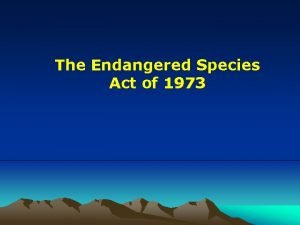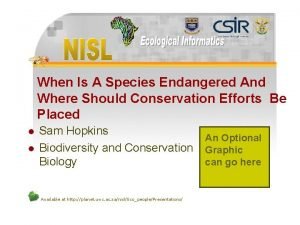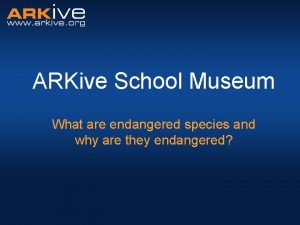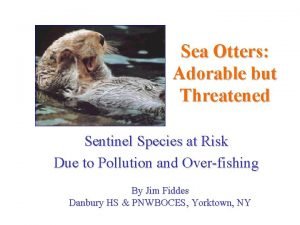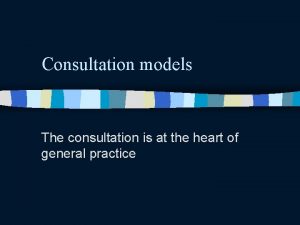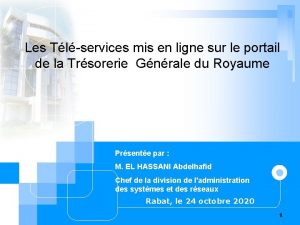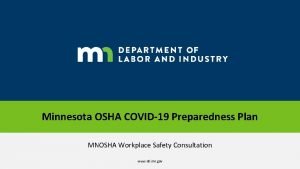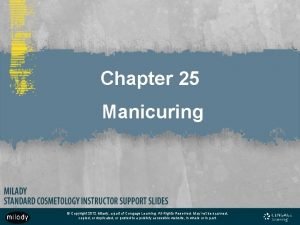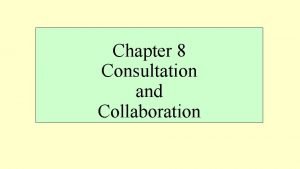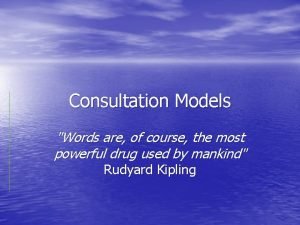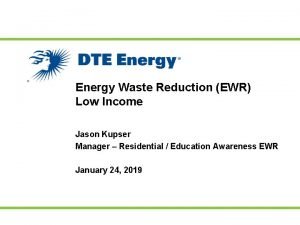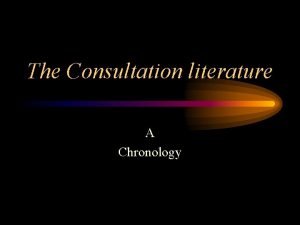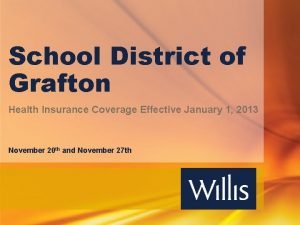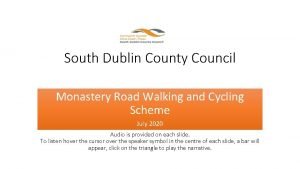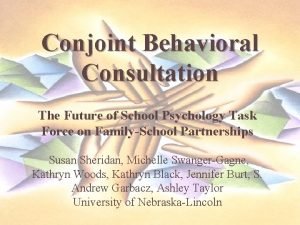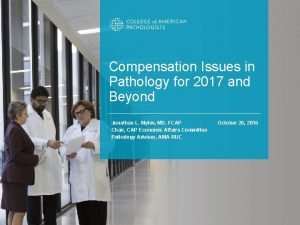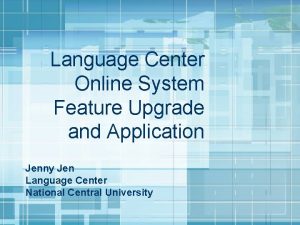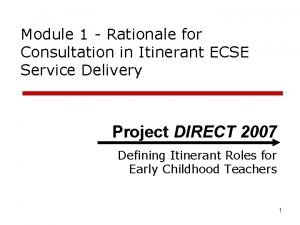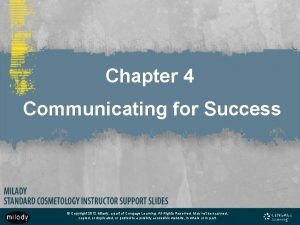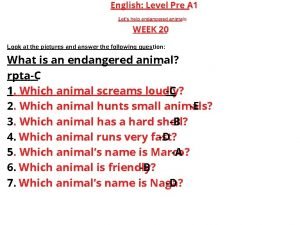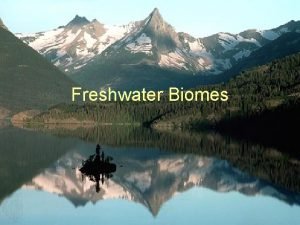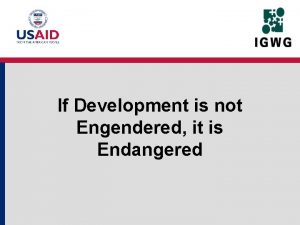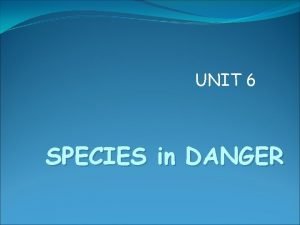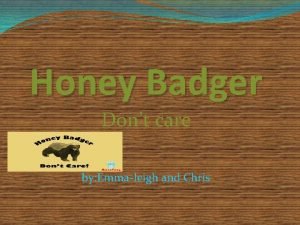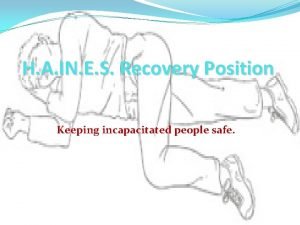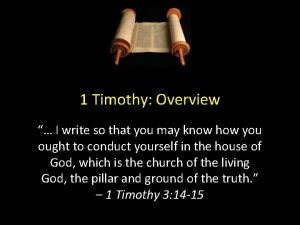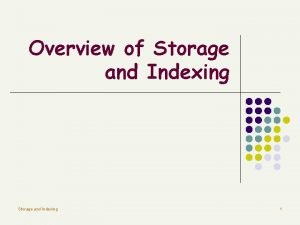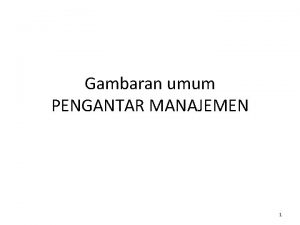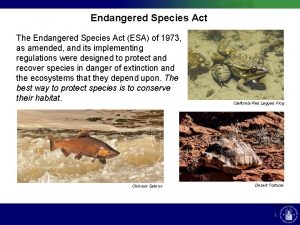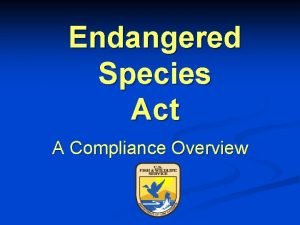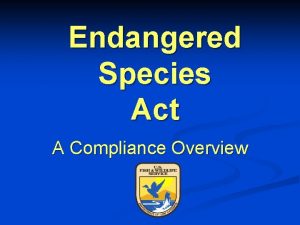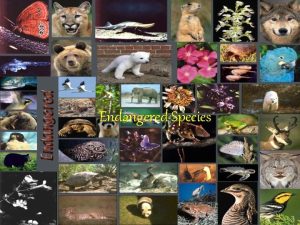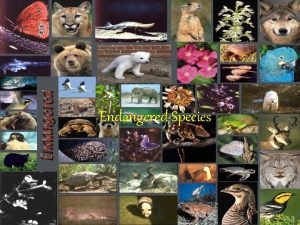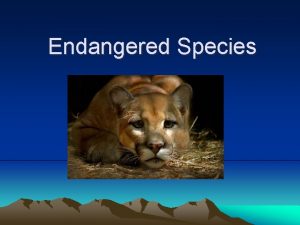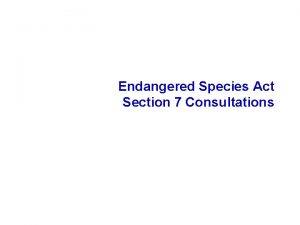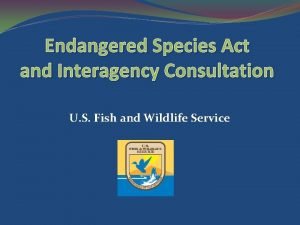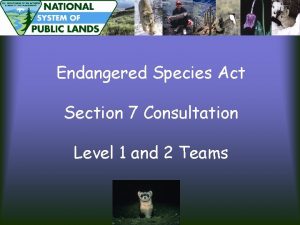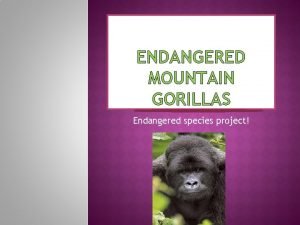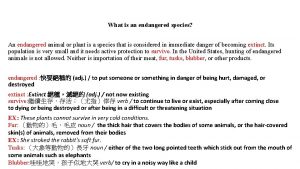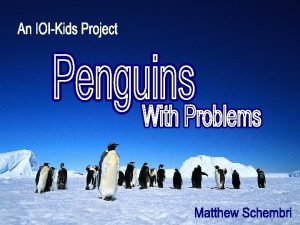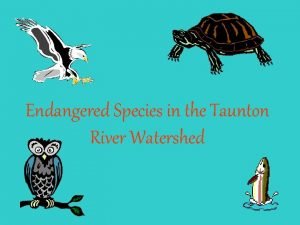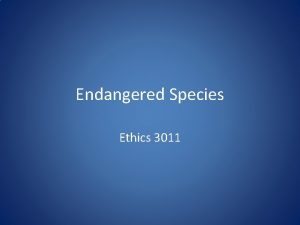Endangered Species Act Consultation Endangered Species Act Overview

























































- Slides: 57

Endangered Species Act Consultation

Endangered Species Act Overview q Signed into law in 1973 q Replaced similar, but less comprehensive laws from 1966 and 1969 q Contains 18 sections, we will discuss one (section 7) in detail

Section 4 -Determination of Endangered and Threatened species- q Listing of species q Listing of critical habitat q 4 d rules for protective regulations q Recovery plans

Section 6 -Cooperation with the states- q Management agreements for conservation q Cooperative agreements for programs q Financial assistance

Section 7 -Interagency Cooperation- q Conservation mandate q Consultation q Conferencing

Section 9 -Prohibited Acts q Prohibited acts for fish and wildlife (take) q Prohibited acts for plants q Prohibited acts regarding import and export

Section 10 -Exceptions- q Scientific take permits q Incidental take permits

Section 7

Section 7(a)(1) -Conservation mandate“(1) The Secretary shall review other programs administered by him and utilize such programs in furtherance of the purposes of this Act. All other Federal agencies shall, in consultation with and with the assistance of the Secretary, utilize their authorities in furtherance of the purposes of this Act by carrying out programs for the conservation of endangered species and threatened species listed pursuant to section 4 of this Act. ” (Act)

Why do we consult?

Section 7(a)(2) -Consultation“(2) Each Federal agency shall, in consultation with and with the assistance of the Secretary, insure that any action authorized, funded, or carried out by such agency… is not likely to jeopardize the continued existence of any endangered species or threatened species or result in the destruction or adverse modification of habitat of such species which is determined by the Secretary… to be critical…. In fulfilling the requirements of this paragraph each agency shall use the best scientific and commercial data available. ” (Act) (Emphasis added. )

Section 7(a)(2) -Consultation. Action - “all activities or programs of any kind authorized, funded, or carried out, in whole or in part, by Federal agencies in the United States or upon the high seas. Examples include, but are not limited to: (a) actions intended to conserve listed species or their habitat; (b) the promulgation of regulations; (c) the granting of licenses, contracts, leases, easements, rights-of-way, permits, or grants-in-aid; or (d) actions directly or indirectly causing modifications to the land, water, or air. ” (Emphasis added. )

Section 7(a)(2) -Consultation- Jeopardize the Continued Existence of – “…to engage in an action that reasonably would be expected, directly or indirectly, to reduce appreciably the likelihood of both the survival and recovery of a listed species in the wild by reducing the reproduction, numbers, or distribution of that species. ” (Regulations) (Emphasis added. )

Section 7(a)(2) -Consultation. Destruction or Adverse Modification– “Destruction or adverse modification means a direct or indirect alteration that appreciably diminishes the value of critical habitat for the conservation of a listed species. Such alterations may include, but are not limited to, those that alter the physical or biological features essential to the conservation of a species or that preclude or significantly delay development of such features. ” (Regulations)

How do we consult?

Consultation Process Guiding documents q The Endangered Species Act of 1973 (as amended) q Regulations (50 CFR Part 402) q 1998 Consultation Handbook q Glossaries in each of the previous documents q Guidance documents q Court Cases

Consultation Process 1 st phase of the process is for the Action agency to assemble documents and information to determine what (if any) impacts/effects to listed species will be caused by the proposed action. This information can be a gathered into a Biological Assessment or some document that can serve the same purpose.

Consultation Process 2 nd phase of the process is where the Service takes the information from the BA and examines that impact along with other conditions to see if the total is likely to cause jeopardy, or destruction or adverse modification. This information is gathered into a Biological Opinion.

What is the purpose of a biological assessment ? To describe all the probable effects to a listed species or designated critical habitat, make a project effects determination, using the correct wording and criteria, for the decision record, and to submit to the Services for consultation.

Consultation Process The Action Deconstruct the action into subtasks or sub -activities


Consultation Process The Action Once deconstruction is well underway ask yourself these questions regarding the activities and sub-activities q q q Who? What? When? Where? How?

Consultation Process Information for consultation “Initiation of … consultation… (1) A description of the action to be considered; (2) A description of the specific area that may be affected by the action; (3) A description of any listed species or critical habitat that may be affected by the action; (4) A description of the manner in which the action may affect any listed species or critical habitat and an analysis of any cumulative effects; (5) Relevant reports, including any environmental impact statement, environmental assessment, or biological assessment prepared; and (6) Any other relevant available information on the action, the affected listed species, or critical habitat. ” [CFR 402. 14(c)]

Consultation Process Status of the species A Rangewide-Scale discussion about the species Legal status Recovery plan or outline Threats Conservation needs General biology Population dynamics

Consultation Process Environmental Baseline q Describe the condition of the environment (and how it got in that condition) q Describe the condition of the Species (Use Reproduction, numbers and distribution) q Describe the condition/extent of the critical habitat (Use primary constituent elements) q Describe how the species uses the action area q How is the action area important (the role) to the conservation of the species

Uncertainty cannot, and will not, be satisfied with silence. We must fill the space with professional judgment based on all the information we have. We use soft data, deduction, observation, extrapolation AND we have to explain why that is reasonable, and what the ramifications may be from the way we structured our assumptions.

Uncertainty The standard for our documents is whether our analysis is reasonable, rational , nonarbitrary; the standard does not require complete absolute knowledge.

Arbitrary and Capricious (1) relied on factors which Congress did not intend the Service to consider, (2) entirely failed to consider an important aspect of the problem, (3) offered an explanation for the conclusion that runs counter to the evidence before the court, (4) offered a conclusion that is so implausible that it could not be ascribed to a difference in view or the product of expertise, or (5) failed to articulate a satisfactory explanation for a conclusion.

Consultation Process Effects of the Action – “…the direct and indirect effects of an action on the species or critical habitat, together with the effects of other activities that are interrelated or interdependent with that action that will be added to the environmental baseline. ” (Regulations)

Consultation Process Effects of the Action Direct effects – “…the direct or immediate effects of the project on the species or its habitats. ” (Handbook) Indirect effects - “…Indirect effects are those that are caused by the proposed action and are later in time, but still are reasonably certain to occur. ” Interrelated Actions – “…those [actions] that are part of a larger action and depend on the larger action for their justification. ” (Regulations) Interdependent Actions – “… those [actions] that have no independent utility apart from the action under consideration. ” (Regulations)

Consultation Process Main Points for Interrelated, Interdependent, and Indirect Effects of the Action q Look outside the “footprint” of the project q Don’t have to overreach or speculate q Test suspected actions and effects against the full definition q Remember the important limiting concepts of “reasonably certain to occur”, “but for” and “caused by”

The Effects of the Action Format and Narrative

‘Connect the dots…’ Projects are made up of activities Activities require tools Tools cause various environmental impacts Impacts can result in species and habitat effects Effects are what we are trying to describe in a Biological Assessments/Biological Opinions

Consultation Process Effects of the action Exposure + Response = Effects Exposure – Which organisms and habitats will be exposed to the changes in land, water, or air? Response – How will the organisms or habitat react to those changes?


Spectrum of Responses in Plants Increasing Severity Sub-Lethal No Re s In <1 Re Re R Re 60 40 20 D Po 0% 10 -2 -80 -60 -40 d p du epr o r u De 0 r od as pr % % ed ced esse som ced u p p o ath cti ba ro ro Fe Gr l tr d ati v b b b an eaf a c ow bio c c e F ab ab un ilit sp ch il ilit on th di a y ira rea i e l of ty di y o ity o y o Ra ur mi tio t de e i tes f d ca f d n ath f de l d on ea ea ea a efe th th ns es cre po ns e Lethal

Consultation Process Writing about effects of the Action q Focus on probable responses to changes in land, water, or air q Effects are explored and discussed at the individual level q Think about the frequency, intensity and duration of the environmental stressors q Use spectrum of responses to describe in detail what is likely to occur from the action to the individuals q Statements need to be what we expect to happen not vague or hypothetical q Remember to have distinct discussions of effects to species and critical habitat

Consultation Process Effects of the Action What about the minimizing effects of conservation measures?

Consultation Process Effects of the Action Conservation measures “…are actions to benefit or promote the recovery of listed species that are included by the Federal agency as an integral part of the proposed action. These actions will be taken by the Federal agency or applicant, and serve to minimize or compensate for, project effects on the species under review. These may include actions taken prior to the initiation of consultation, or actions which the Federal agency or applicant have committed to complete in a biological assessment or similar document. ” (Handbook)

Effects discussion Example of summary showing the logic and connecting the dots (without conservation measures) Bull trout use the area for spawning The project will generate large amounts of sediment The sediment will settle in spawning gravels Spawning gravels will be much reduced in quality Spawning bull trout will not use the gravels, or will have less egg hatching success if they do use them.

Effects discussion Here’s the same example with conservation measures. Bull trout use the area for spawning The project will generate large amounts of sediment, but sediment mats and pumps will keep the sediment from settling in spawning gravels Impacts to spawning gravels will not be measureable Effects to spawning bull trout using gravels will not be detectable The effects to bull trout (through effects to spawning) will be insignificant.

Consultation Process Writing Tip Claim vs. Rationale “The logging project will negatively affect spotted owl nesting, by reducing their reproduction. ” “Spotted owls nest in trees greater than 16 inches diameter at breast height, and that size of tree is limited in the action area. The proposed commercial logging project, targets removal of trees over 16 inches. That will result in a reduction in potential nest trees, reducing nesting and reproduction opportunities by as much as 50 percent. ”

Consultation Process Effects of the Action Discussion narrative can sometimes be organized this way ü ü Science background on stressor Likely response in this proposed action’s situation Modified by conservation measures Final conclusion on degree and extent of effect from that stressor [Remember frame effects in terms of reproduction, numbers, distribution or physical or biological features]

Consultation Process Cumulative effects Section 7 definition “…are those effects of future State or private activities, not involving Federal activities that are reasonably certain to occur within the action area of the Federal action subject to consultation. ” (Regulations)

Consultation Process Cumulative effects (to the species) q q Future non federal In the action area Not same as NEPA Need the effects to the species, not just a list of activities Again – think in reproduction, numbers, and distribution or physical or biological features

Consultation Process synthesis and effects determination = Condition of environmental baseline Future impacts from cumulative effects + Effects of the action _____________ Effects to the species or CH for proposed action

Conceptual representation of the dependent relationship between baseline condition for the species in an action area and a project’s effect determination Condition of the environmental baseline relative to the needs of the species Proposed action Increasing negative effect to species in the action area May affect, Not likely to adversely affect May affect, likely to adversely affect

Consultation Process effects determination Examine the effects against the three possible categories anticipated by consultation q No effect q May affect. . but not likely to adversely affect or likely to adversely affect.

Consultation Process No effect category No effect “…the appropriate conclusion when the action agency determines its proposed action will not affect a listed species or designated critical habitat. ” (Handbook)

Consultation Process Not likely to adversely affect category “…the appropriate conclusion when effects on listed species are expected to be discountable, insignificant, or completely beneficial. ” Beneficial effects are contemporaneous positive effects without any adverse effects to the species. Insignificant effects relate to the size of the impact and should never reach the scale where take occurs. Based on best judgment, a person would not be able to meaningfully measure, detect, or evaluate insignificant effects. Discountable effects are those extremely unlikely to occur. Based on best judgment, a person would not expect discountable effects to occur. (Handbook)

Consultation Process likely to adversely affect category May affect, likely to adversely affect………? ? . . . . anything that doesn’t fit the May affect, but not likely to adversely affect category

Consultation Process Avoid phrases that don’t align with criteria… “…little if any effect. ” “. . . Large effect. ” “…not very significant effect. ” “…not much of an effect. ” “…low impact. ”

Consultation Process effects determination Determinations are based on impacts to individuals, not populations Determination is based on the most impactful effect – it is not a balancing process Important to have your language in the effects discussion match the category criteria Environmental condition can impact effects call Need an individual determination for species and a determination for designated critical habitat It is not a judgment abut the value or importance of the project – just a criteria to drive process


Reoccurring weaknesses in BAs and BOs 1. Incomplete description of the proposed action, subtasks, and tools involved – Think Deconstruction/Brainstorm 2. Failure to organize the document in a logical way – think Project Activities Tools Impacts Effects 3. Including information about the species in the Status section and literature review that is not pertinent to the effects of this particular proposed action. 4. Description of the Environmental Baseline does not include specifics regarding the listed species in the Action area - Think specific reproduction, numbers, and distribution.

Reoccurring weaknesses in BAs and BOs 5. Terms used in description of the effects of the action do not align (and may even contradict) the criteria for the effects determination categories – review criteria and keep in mind as you are writing the effects section 6. Failure to be specific regarding probable response and effects to the listed species – Think individuals and their probable response and the effect of that response. 7. Use of ambiguous words in predicting effects – Avoid may, should, could, might, potential, etc. 8. Conclusion statements without clear supporting rationale - Connect the dots. Don’t make the reader re-read the entire document to find the argument.

Reoccurring weaknesses in BAs and BOs 9. Confused organization of document regarding scientific or literature background on effects and actual predicted effects of the proposed action – Make sure reader knows when you’re shifting between the two. 10. Effects determinations erroneously based on population effect rather than individuals – Focus on exposure, response and effect of individuals. 11. Effects determinations based on “balance of effect” – Remember that the correct category follows the greatest effect on any one individual.
 What is the endangered species act of 1973
What is the endangered species act of 1973 Conclusion of endemic species in india
Conclusion of endemic species in india Earth day endangered species
Earth day endangered species Pop art 1960
Pop art 1960 A lot of different conservation efforts have been made to
A lot of different conservation efforts have been made to Arkive endangered species
Arkive endangered species Sea otter endangered species
Sea otter endangered species Keystone plant
Keystone plant Gp consultation models
Gp consultation models Neighbours inner consultation model housekeeping
Neighbours inner consultation model housekeeping Consultation skills for pharmacy practice
Consultation skills for pharmacy practice Bradford vts consultation models
Bradford vts consultation models Tgr banque en ligne
Tgr banque en ligne Mn osha consultation
Mn osha consultation Basic manicure steps milady
Basic manicure steps milady Triadic dependent
Triadic dependent Balint consultation model
Balint consultation model Caplan's four types of consultation
Caplan's four types of consultation Neighbours inner consultation model housekeeping
Neighbours inner consultation model housekeeping Deer oaks consultation services
Deer oaks consultation services Balint consultation model
Balint consultation model Dteenergy.com/hec
Dteenergy.com/hec Home buyer consultation
Home buyer consultation Pendleton 7 tasks
Pendleton 7 tasks Service delivery consultation
Service delivery consultation Coverage consultation grafton
Coverage consultation grafton Sdcc consultation portal
Sdcc consultation portal Behavioral consultation
Behavioral consultation Consultation skills for pharmacy practice
Consultation skills for pharmacy practice Microslide consultation
Microslide consultation Wedding consultation form
Wedding consultation form Practice standards for consultation skills
Practice standards for consultation skills Consultation collocation
Consultation collocation Triadic consultation
Triadic consultation Pa osha consultation
Pa osha consultation What are the golden rules of human relations?
What are the golden rules of human relations? Macbeth summary
Macbeth summary Is tiger an endangered animal
Is tiger an endangered animal Listen to three conversations about animals
Listen to three conversations about animals Endangered animals of north america
Endangered animals of north america Endangered animals in russia
Endangered animals in russia If development is not engendered it is endangered
If development is not engendered it is endangered Survive and protect the endangered plants
Survive and protect the endangered plants Are margays endangered
Are margays endangered Are honey badgers endangered
Are honey badgers endangered Nautilus endangered
Nautilus endangered Define recovery position
Define recovery position Invasive species act ontario
Invasive species act ontario Crtd in sap
Crtd in sap Ey it advisory
Ey it advisory 1 timothy overview
1 timothy overview Overview of microprocessor
Overview of microprocessor Overview of storage and indexing
Overview of storage and indexing Gambaran
Gambaran Kv charts in software testing
Kv charts in software testing Figure 12-1 provides an overview of the lymphatic vessels
Figure 12-1 provides an overview of the lymphatic vessels Overview of grid computing
Overview of grid computing Infrastructure of m commerce
Infrastructure of m commerce
